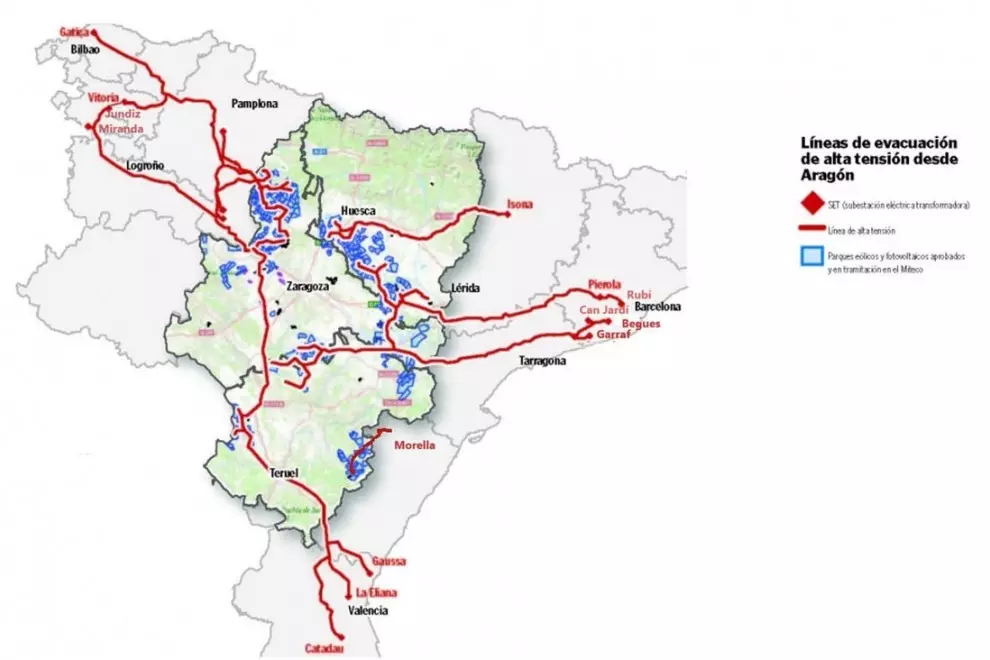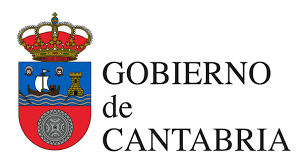Guardia Civil and Public Prosecutor’s Office denounce in court illegalities in renewables designed to alleviate nuclear blackout

The Public Prosecutor’s Office and the Armed Forces see indications of environmental crimes and prevarication in the processing of 62 wind and solar power plants and four power lines deployed in Teruel, Zaragoza and Huesca.
The Public Prosecutor’s Office and the Guardia Civil have detected indications of environmental crimes and prevarication in the processing of authorizations to install 53 wind farms and nine solar plants in Teruel, Zaragoza and Huesca and to build four high voltage lines whose purpose is to transfer their electricity production to Catalonia and Valencia, according to the documentation to which access has been obtained. Public. The investigations question the legality of the actions of Miteco (Ministry of Ecological Transition) and the Government of Aragon, responsible for the processing of 46 and 20 of these projects, respectively.
They have their origin in the blocks of complaints that the citizens’ movement Teruel Existe has been presenting to the Environmental Prosecutor’s Office and the three Aragonese provincial courts. The Zaragoza prosecutor’s office opted to close the proceedings concerning four wind power plants and seven photovoltaic plants in that province as there was no evidence of a crime, a criterion not shared by the other two provincial prosecutors’ offices or the Guardia Civil. In their complaints to the courts, the prosecutors see indications of the possible existence of environmental crimes in the processing of the files for, basically and allegedly, omitting the occupation of protected areas or their proximity to some of them. As well as for analyzing projects in pieces without taking into account their overall impact or for ignoring procedural requirements in terms of processing times, public information periods or administrative formats or, also, for lacking the mandatory archaeological studies in some cases.
These alleged omissions would have resulted, according to the complainants, in the issuance of authorizations to install the wind farms in areas where the legislation prohibits their presence, or at least limits it or makes it conditional on the application of measures to mitigate their impact. Something that, in their opinion, does not quite fit with situations such as the location of 90 of the 125 wind turbines of a block of wind farms in the Maestrazgo area on Natura Network land. These judicial and police movements have repercussions in several areas, as they imply the judicialization of a model of deployment of renewables, on a macro scale and that bypasses self-consumption, which has long been strongly contested by the population of the affected areas. It also implies questioning the model of macro-transfer of energy from the emptied Spain to the poles of industrial development, which is nothing more than a replica with the wind and light of the steppes of the hydroelectric model with which Franco’s regime devastated the valleys of half of Spain.
The Spanish Government has opted for this format in view of the threat of energy collapse that the scheduled shutdown, due to obsolescence, of the Ascó, Vandellós and Cofrentes nuclear plants between July 2030 and October 2031 represents for Catalonia and the Valencian Country, which together account for 28% of GDP. In fact, the map that accompanies this information makes clear the scheme for the installation of wind and solar farms in rural areas of Aragon to transport this energy to these two communities and also to the Basque Country (5.8% of GDP). aragonese company Forestalia, the main beneficiary of the renewable auctions of 2016 and 2017, and which have caused a hard clash between Miteco and the Catalan Government, opposed to their routes due to their environmental effects. The judicialization of the deployment of renewables leaves in the air the distraction maneuver initiated a few weeks ago in Aragon by PP and Vox with the registration of a commission of inquiry into the management of the previous regional government, the four-party PSOE-Podemos-Par-Cha of Javier Lambán, in this matter. One of its objectives, as announced by the spokesmen of both groups, Rafael Ledesma and Santiago Morón, is to take the conclusions to the Public Prosecutor’s Office if during the sessions of the commission there were indications of a crime in the processing of the environmental authorizations. However, the Teruel Existe initiative, which includes the four high voltage lines to Catalonia (Sant Just, Begués and Garraf) and the País Valencià (Morella), disarms and exposes the right wing’s move, since it is already on a more advanced screen such as that of the court, at the same time as it pillories the management of the quadripartite. In any case, the practice of the PP-Vox Government is far from what would be its promised (in campaign) regulation of the sector, since the authorizations of Industry and Environment for lines and parks continue to cascade, one day after another, in the official gazette. The pace has reached the point that in the last few days environmental permits have been granted for the installation in a municipality with a moratorium in force for this type of plants such as Sabiñánigo (Huesca) of three nearby photovoltaic parks, from the same developer (Enerland) and sharing the same evacuation line and name (Sabiñánigo I, IV and VI). Nor has Miteco lifted its foot off the accelerator in its part of the renewable deployment. This trend is symptomatic of the BOE’ s choice of October 12, a public holiday (even more so in Aragon) and the beginning of a long weekend, to publish the administrative authorizations for six wind power plants in six towns in Teruel and Zaragoza. Guardia Civil investigates project splitting
The Uprona (Nature Protection Unit, formerly Seprona) of the Civil Guard of Huesca, to which the Prosecutor’s Office of Huesca entrusted a series of investigations, adds to the possible environmental infractions denounced by Teruel Existe the suspicions of prevarication, focusing on a practice more than frequent in the field of renewable energies such as the splitting of projects. Fractioning consists of splitting the presentation of a power plant project into several smaller projects, almost always adjacent (or at least close) and sharing transformer stations and evacuation and transmission lines, with two basic objectives: to reduce the environmental impact assessment of the design as a whole and to mitigate risks in order to bid for network access authorizations. In an operation similar to that of the environmental aspect, it is a question of opting for the connection with several generation flows of lesser importance than the whole, which would always be more difficult to accommodate in a sector in which the supply is clearly oversized and continues to do so in spite of the bubble pricksemissions, compared to the capacity of the transmission and distribution networks. The splitting also defines, if accepted, which Administration must supervise the projects: the state when the power exceeds 50 MW (megawatts) and the autonomous administration below that figure. The complaint points to the core of the investigation: environmental effects and prevarication.
The Autonomous Administration, in view of the facts, should have paralyzed the authorization files (of the split projects) at the moment of detecting that it was a single entity”, concludes Uprona in a report. In this he adds that “they should have informed the companies that they had to present a single project to the central administration, and invalidate everything that had been processed until then”. And how could it be known that it was a subdivision? The Guardia Civil lists several “symptoms” such as “the separate request for the construction of elements that were part of more than one park, the ownership of the companies, the proximity of some parks to others, or simply the amount of Mw produced that would result from the sum of several of these parks”.
“By not having done so -the report continues-, it is the opinion of this force that a crime of prevarication could have been committed […] by having issued resolutions […] absolutely arbitrary”. A practice in which he points as suspects to “the direction of the provincial service of Industry and Innovation of Huesca, as well as the direction of Inaga”, the Aragonese Institute of Environmental Management, in the last legislature, the second of Javier Lambán’s quadripartite. “The aim is to determine whether there are irregularities in the contracts denounced in the Public Prosecutor’s Office and confirmed by the report of the Uprona of the Guardia Civil and whether they involve that extra unlawfulness that requires the intervention of criminal law,” says the Environmental Prosecutor of Huesca in the complaint by which she sends to court the installation of four wind farms (Santa Cruz I, Expansion and IV and San Isidro II) in the towns of Berbegal, Castelflorite and Peralta de Alcofea).
The complaint points out the core of the investigation: environmental effects, on the one hand, and prevarication, in which it is to discern whether they have been “carried out by action or omission mere irregularities or non-compliance required by a rule” or whether it is “malicious actions carried out with awareness and willingness to alter the administrative procedure […] to perform an act for the benefit of a person” and with “obvious prejudice” to others so that “the entity of the act is of gravity and relevance that entails a clear injustice of it knowing that it is”. Mariano Tomás: “Many more wind and solar plants are being installed than would actually be necessary”. Mariano Tomás, member of the Energy and Environment Group of Teruel Existe, which has coordinated the collection of information, and also the appeals against 42 plants and the allegations against 250 projects throughout Aragon, testifies this Tuesday as a witness by videoconference from Alacant before the Court number 2 of Huesca, which is the one investigating the alleged irregularities in the four parks reported in that province. “There is no will for there to be energy in the territory, and there is a will for the big companies to manage the business. All the facilities that are being given to large companies are obstacles for self-consumption and energy communities,” he explains. “There is no right that we have to be a territory of sacrifice because a system is designed that is not efficient,” he adds, referring to one of the obvious consequences of the model chosen by the administrations, in which losses during transport from the farms to the factories in Catalonia, Valencia and the Basque Country can reach 20% of production. “This means that many more wind and solar plants are being installed than are actually needed and that the country will be filled with towers and lines that are not necessary,” he notes. “What sense does it make to deploy these parks in areas like Matarraña, where the only livelihood is already practically tourism? They intend to take away the livelihoods of the people of Teruel and leave the industry where it already was. They push people to leave and lure them to where they want them to go,” he concludes.
Parks under judicial investigation.
The list of wind farms that, in addition to those in Huesca and the high voltage lines, are under judicial investigation in Teruel, although the investigations include some municipalities in the neighboring area of Zaragoza, are as follows. On the one hand, and with processing by the Government of Aragón, Las Cerradas and Las Cuencas in Cuevas de Almudén, Escucha and Jarque de la Val; Valdenebro in Muniesa; Segura I and II in Huesa del Común, Loscos and Monforte; Montesol in Cañada Vellida; Ancar I, II, III and IV in Alfambra and Orriols and also Alpenés, Morteruelo, Portalrubio, Piedrahelada and Mínguez in Alpeñés, Cosa and Pancrudo. With the files in charge of Miteco, Cabecero I, II, III and IV, Concejo I, II and III, Cid I, II, III. IV and V, La Estrella I, II, III and IV and La Vacada I, II, III, IV, V and VI, located in Fortanete, Mosqueruela, la Iglesuela del Cid, Cantavieja, Villarluengo, Mirambel, Tronchón and Puertomingalvo. Also La Masía I and II in Mosqueruela, Puertomingalvo and Linares de Mora, as well as Angus, Brigid, Dian, Fulgora, Belenus, Epona, Electra, Felis and Fontus, located in Lécera, Muniesa, Moneva, Lagata, Albalate del Arzobispo, Blesa, Huesa del Común, Azuara, Moyuela, Villar de los Navarrs, Herrera de los Navarros and Almonacid de la Cuba. The Jaime I, Hornos, Lera and San Vicente plants, which extend over the municipalities of Lechón, Cucalón, Salcedillo, Bea, Lanzuela, Lagueruela, Allueva, Fonfría, Vivel del Río Martín, La Hoz del Río Martín, La Hoz del Río Martín, La Hoz del Río Martín, La Hoz de la Vieja, Maicas and Segura de Baños, complete this last block of ministerial processing, Fonfría, Vivel del Río Martín, La Hoz de la Vieja, Maicas and Segura de Baños, and those of Cerbero, Menecio, Oalas, Perses, Odiseo and Selene, located in Alcañiz, Mazaleón, Valdealgorfa, Valjunquera, Valdetormo and Maella.
Source.
https://www.publico.es/sociedad/guardia-civil-fiscalia-denuncian-juzgado-ilegalidades-renovables-disenadas-paliar-apagon-nuclear.html?s=08






